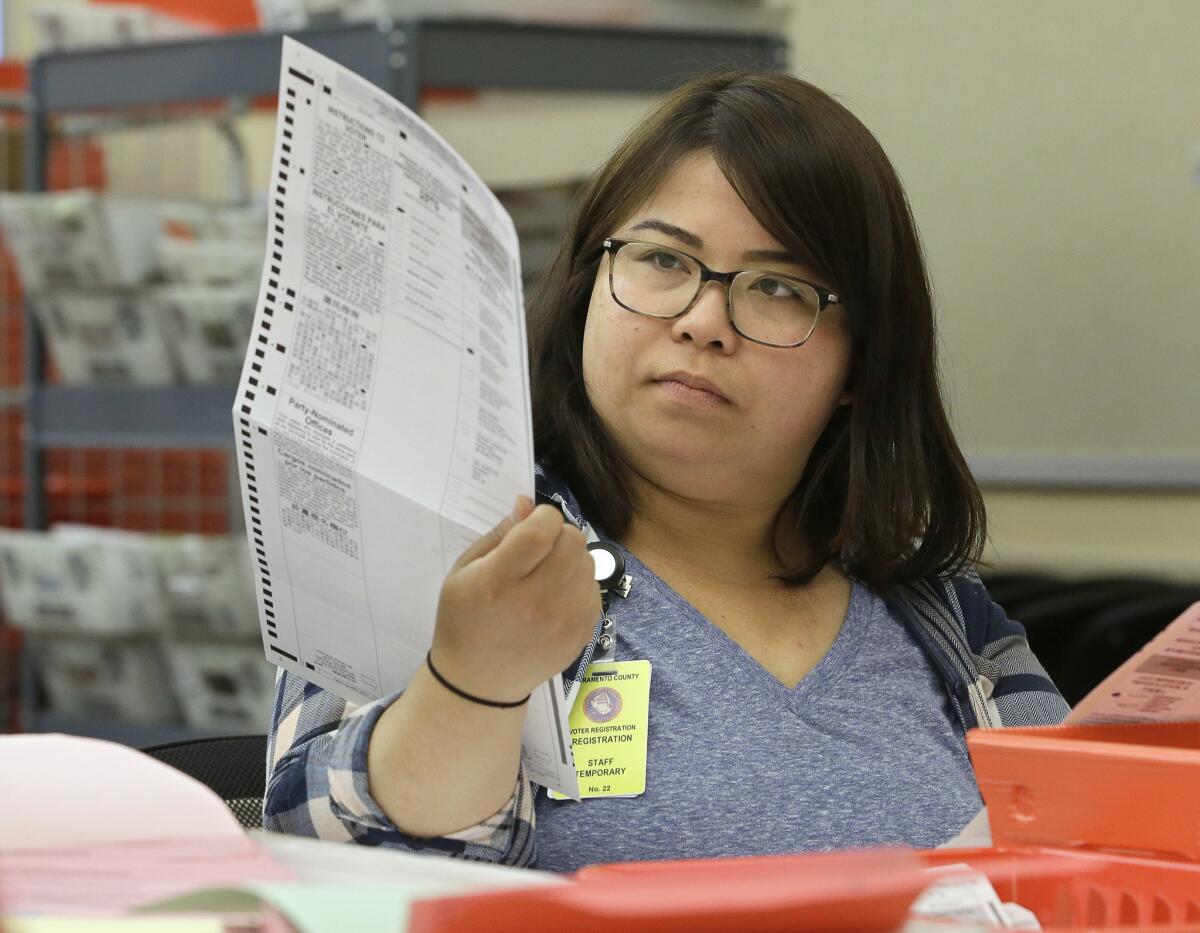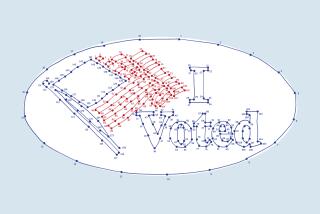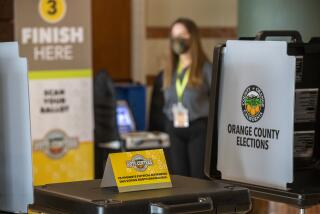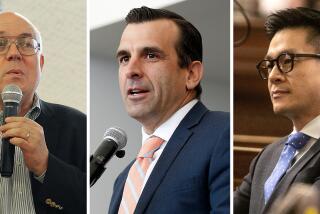‘Confusing’ California primary ends on sour note

Reporting From Sacramento — State officials will write the June 7 primary’s final chapter this week by certifying that more than 8.5 million ballots were cast, though it’s unlikely to assuage voters or local elections officials who complained that overlapping and confusing rules left them with a lingering political hangover.
“It’s disheartening because people’s expectations were so high,” said Kim Alexander, president of the nonpartisan California Voter Foundation. “There were a lot of unhappy voters.”
The primary’s sour ending note seems largely due to the asymmetric rules governing the presidential and statewide elections. Unlike the primary for state races – where anyone could vote for any candidate – the presidential contests were governed by a patchwork of rules that differed by political party.
“The presidential primary is always the most difficult to conduct,” said Michael Vu, San Diego County’s registrar of voters.
Independent voters, known in California as having “no party preference,” were allowed to vote in the Democratic primary between Hillary Clinton and Vermont Sen. Bernie Sanders. But they were banned from voting in the Republican presidential primary.
The Democratic Party required unaffiliated voters to use a special “crossover” ballot so they couldn’t vote for the party’s governing committee — but voters had to proactively ask elections officials for the special ballot.
“The parties set the rules,” said Dean Logan, county clerk-registrar of voters in Los Angeles County. “The presidential primary is not designed with voters in mind.”
Get the latest news on what’s happening in California politics »
Those rules were supposed to be enforced by local elections officials, but procedures varied county to county. Activists, many of which were fervent Sanders supporters, leveled accusations that some independent voters were being cheated out of voting for the insurgent Democrat.
Reports on election day found a number of polling place flash points, where workers either offered the wrong advice or didn’t use the latest roster of registered voters.
California does not have a uniform system for what kind of training, or how much, to give poll workers.
“There is no statewide standard, and we’re all left to interpret these things county by county,” said Joe Canciamilla, registrar of voters in Contra Costa County.
Canciamilla’s office made headlines when state officials balked at the county’s decision to give a provisional ballot to any “no party preference” voter who received a ballot by mail but then decided to cast a vote at a polling place.
Those voters are supposed to exchange their original ballot, but some left them at home. Either way, Contra Costa officials offered a provisional ballot, reserved for those whose eligibility can’t quickly be determined on election day.
“That gives us a clear opportunity to check that voter,” Canciamilla said of his county’s use of provisional ballots.
In other states, critics charged that provisional ballots went uncounted. And by the time the presidential race made it to California, Sanders supporters used social media to urge people to refuse a provisional ballot.
Elections officials countered that California’s election law allows wide discretion to accept those votes. The final report in Contra Costa County showed 88% of provisional ballots were successfully counted. In Los Angeles County, where more than 268,000 provisional ballots were cast, 87% were ultimately counted.
Registrars reported more citizens than in prior years showing up after election day to observe the counting of provisional ballots. In San Diego, activists took to Facebook and Twitter last week with accusations that elections workers were changing provisional ballots.
In one sense, they were right. Because some voters showed up in a different part of the community from where they were registered, they mistakenly voted in down-ticket races for which they weren’t eligible to participate. San Diego election workers “redacted” those mistaken votes with white correction tape, leaving intact choices made for president and U.S. Senate.
“We have to redact those votes in which you were not eligible,” Vu said.
In some counties, those ballots are “remade” with election workers copying all of the voter’s selections to a new ballot, the same process used when a ballot is damaged but a voter’s intent is clear.
San Diego County still faces a lawsuit filed by an activist group that claimed elections officials used the wrong standard in conducting the required post-election manual recount of 1% of ballots.
Alexander of the California Voter Foundation said there should be more information online about how votes are counted. “That would help clear up some of the confusion,” she said. “People are ready to claim fraud in a heartbeat.”
Elections officials struggled, too, with infrequent voters who were energized by the presidential race but didn’t know to which party they were registered. Many waited too late to make changes, including some who believed they were independent of all parties but actually were members of California’s American Independent Party.
Last week, allegations were made in Riverside County that some voters may have had their party affiliations tampered with by changes made using the state’s online registration portal. In a written statement, Secretary of State Alex Padilla said there are no “substantiated claims from district attorneys and county registrars of unauthorized political party affiliation changes.”
Meantime, a number of votes arrived at local elections offices at the last minute. A series of election changes in 2014 included a law that required ballots arriving as many as 72-hours late to be counted, as long as they had a postmark of election day (in this case, June 7).
“For some reason, they like to hand them in at the polls or mail them the day of the election,” said William Rousseau, Sonoma County’s clerk-recorder-assessor.
Election workers in Rousseau’s small community had to sift through 43,000 mailed ballots that were either turned in on election day or arrived during the following three days. Votes from Sonoma were among some of the last ones counted in the state.
In the end, the biggest challenges may have been caused by both mechanics and money.
Though election procedures vary by California county, interviews with officials from across the state found broad agreement on the need to update voting systems. Those devices, they said, are ill-equipped to handle so many different ballots by party and language as well as super-sized races like the 34 primary candidates in the race for the U.S. Senate.
Elections, say observers, continue to be underfunded, with more money needed both to expand outreach and to pay for procedures mandated by the state.
“We had so many complex rules in this election,” Alexander said. “There’s got to be a way to achieve the kind of uniformity and equal treatment of voters that people expect, and money is the way you do that in California law.”
ALSO
It only took a month to count California’s votes. Here’s why, and why it may get better
Unusual election outcomes are the new normal with California’s top-two primary rules
5 million Californians are expected to vote by mail, a new record for a statewide primary
More to Read
Get the L.A. Times Politics newsletter
Deeply reported insights into legislation, politics and policy from Sacramento, Washington and beyond. In your inbox three times per week.
You may occasionally receive promotional content from the Los Angeles Times.











